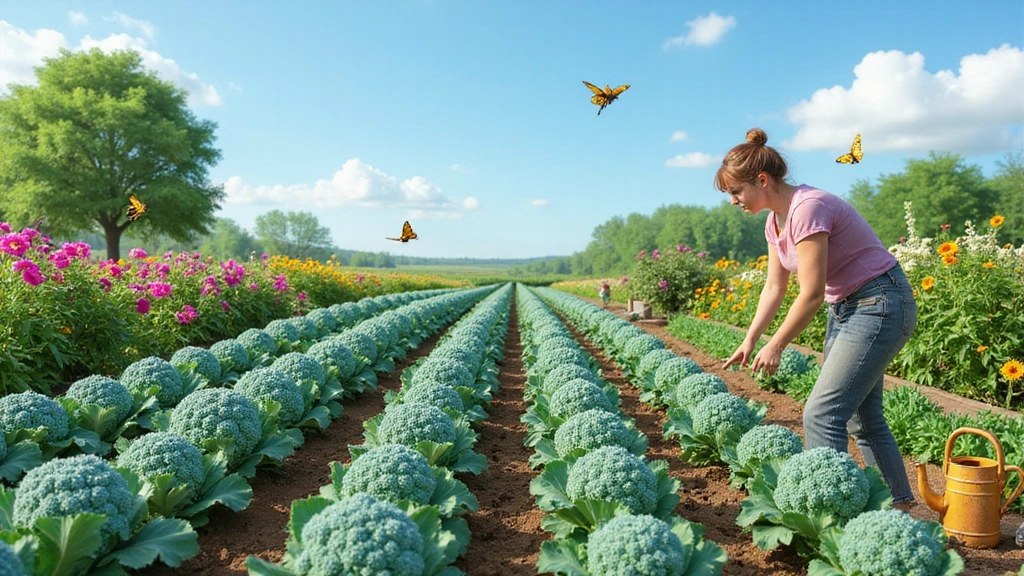If you’ve ever dreamed of harvesting your own fresh broccoli, you’re not alone.
Growing this nutritious vegetable at home can be a delightful and rewarding experience, filling your garden with lush greens and vibrant colors.
In this guide, we will walk you through everything you need to know about growing broccoli, from selecting the right seeds to caring for your plants, ensuring you enjoy a bountiful harvest.
Get ready to dig into the world of vegetable gardening and transform your home garden into a flourishing broccoli haven!
Contents
- Step 1: Choosing the Right Variety
- Step 2: Preparing Your Garden Bed
- Step 3: Sowing Seeds
- Step 4: Watering and Fertilizing
- Step 5: Pest and Disease Control
- Step 6: Thinning Seedlings
- Step 7: Supporting Your Broccoli
- Step 8: Harvesting Broccoli
- Step 9: Storing Your Harvest
- Step 10: Continuing Your Gardening Journey
- Step 11: Understanding Seasonal Changes
- Step 12: Experimenting with Companion Planting
- Step 13: Learning from Mistakes
- Step 14: Embracing Organic Gardening
- Step 15: Celebrating Your Harvest
Step 1: Choosing the Right Variety

Broccoli is available in a variety of types, each tailored to thrive in specific climates and growing conditions.
Among the most popular varieties, you’ll find Calabrese, known for its large, robust heads, and Sprouting broccoli, which produces smaller side shoots that allow for multiple harvests throughout the season.
To kickstart your gardening journey, consider purchasing Calabrese Broccoli Seeds or Sprouting Broccoli Seeds, both of which can be a great addition to your garden.
Additionally, using an Organic Fertilizer will help nourish your plants and set the groundwork for a bountiful harvest. Researching which variety performs best in your area will further enhance your chances of success, whether you choose heirloom or hybrid seeds.
Step 2: Preparing Your Garden Bed
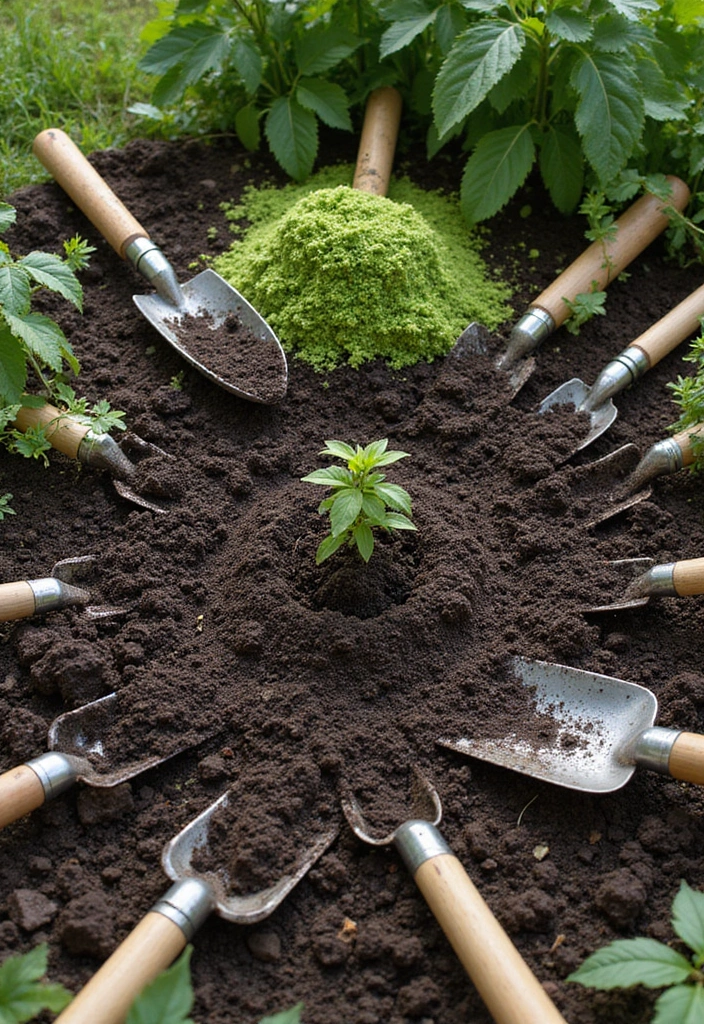
Broccoli thrives in rich, well-drained soil with a pH level ranging from 6.0 to 7.0. To ensure your garden bed is ready for planting, it’s important to amend the soil with nutrient-rich materials like compost or well-rotted manure.
Additionally, make sure to clear away any weeds and debris, providing a clean and inviting space for your new plants to flourish. Using a garden rake can be particularly helpful for this task.
If you find that your soil is heavy or clay-like, consider building raised beds. This approach can significantly improve drainage and temperature control, giving your broccoli the best chance for a bountiful harvest. You may also want to incorporate soil amendments to further enhance soil quality. Finally, a trowel set will be invaluable for planting your seeds or seedlings with precision.
Step 3: Sowing Seeds

Broccoli seeds can be sown directly into your garden or started indoors for an earlier harvest, giving you the flexibility to choose what works best for your growing conditions.
When planting, ensure you place the seeds about 1 inch deep and 18 inches apart to provide ample space for healthy growth. If you opt to start your seeds indoors, consider using Seedling Starter Trays for optimal seedling development. Transplant them into the garden when they reach about 4-6 weeks old.
It’s crucial to keep the soil consistently moist until the seeds germinate, which typically takes around 7-14 days. To make this task easier, you might want to invest in a Garden Watering System, ensuring your seedlings receive the right amount of water. Don’t forget to protect your hands while gardening—using a pair of durable Garden Gloves will keep them safe and comfortable as you nurture your broccoli plants!
Step 4: Watering and Fertilizing

Consistent watering is crucial for cultivating healthy broccoli plants. Aim to provide approximately 1 to 1.5 inches of water each week, which can come from natural rainfall or through supplemental watering methods.
Consider using a watering can for effective hand watering, or invest in a drip irrigation kit to ensure a consistent water supply directly to the roots.
Additionally, to nourish your broccoli, apply a balanced fertilizer every 4 to 6 weeks. A soil moisture meter can help you monitor the moisture levels in your soil, ensuring your plants receive just the right amount of water.
Keep a close eye on the leaves; if they begin to turn yellow, it could be a sign of nitrogen deficiency, indicating that it’s time to adjust your fertilization routine.
Step 5: Pest and Disease Control
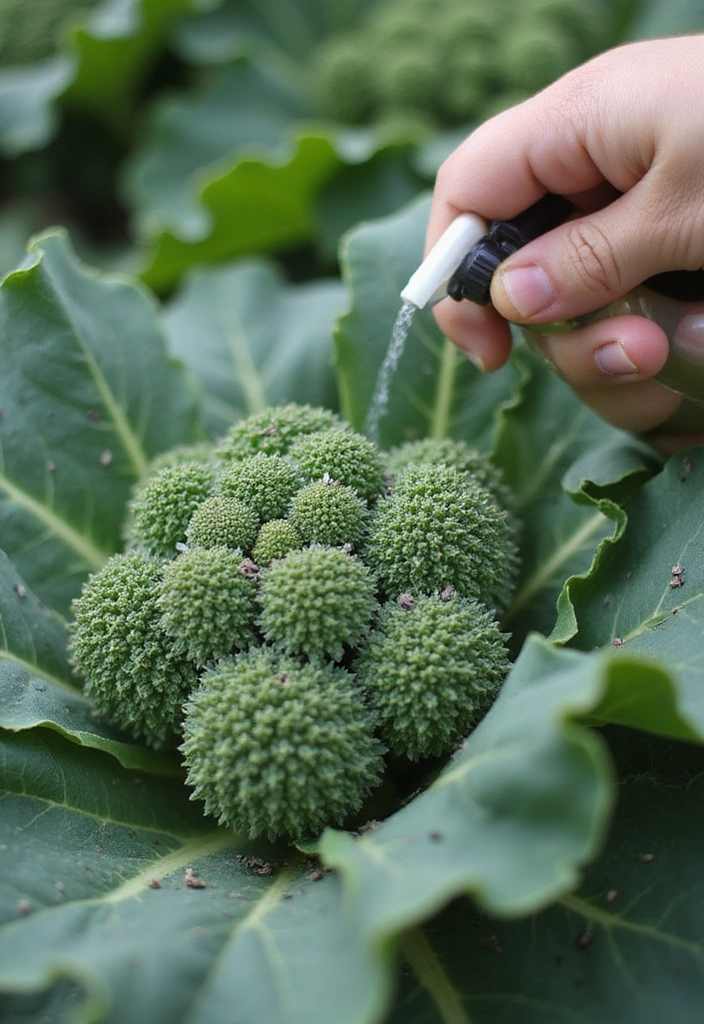
Broccoli is susceptible to pests such as aphids and cabbage worms, which can wreak havoc on your plants.
To combat these pests, it’s essential to regularly inspect your broccoli for any signs of infestation. Consider using organic solutions like neem oil or insecticidal soap to protect your plants effectively.
Additionally, integrating companion planting with herbs such as dill or marigolds can serve as a natural deterrent against unwanted pests. You can find a variety of these seeds at this link: Companion Plant Seeds.
It’s also vital to monitor your broccoli for any signs of disease, like yellowing leaves, as early detection can help you address issues before they become severe. For a comprehensive approach to managing pests, consider investing in a Garden Pest Control Kit to keep your plants healthy and thriving.
Step 6: Thinning Seedlings
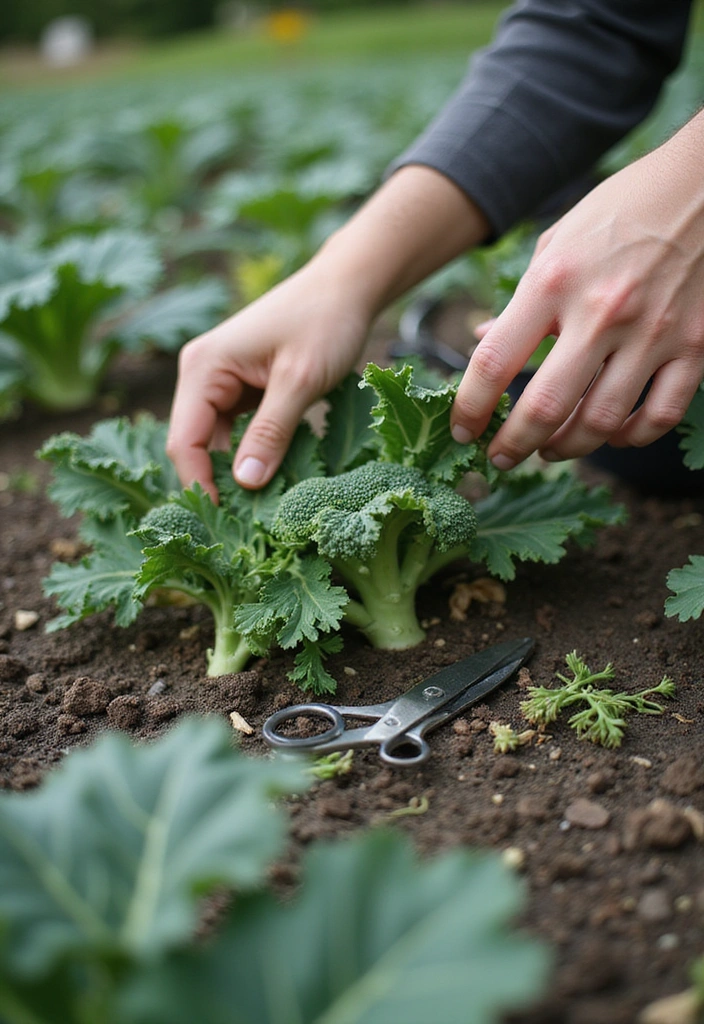
Once your broccoli seedlings have developed their first true leaves, it’s time to thin them out to ensure optimal growth. This step is crucial, as it allows each plant sufficient space to flourish, minimizing overcrowding and competition for essential nutrients.
To effectively thin your seedlings, aim to provide about 18 inches of space between each plant. Carefully snip the weaker seedlings at the base using garden scissors for a clean cut.
While you’re at it, consider using seedling labels to keep track of your plants and their spacing, which can be particularly helpful in larger gardens. For added comfort while tending to your plants, a gardening kneeler can make the process easier on your knees and back.
Finally, using a plant spacing guide can help ensure that you’re maintaining the right distance between seedlings, and a soil test kit will provide valuable insights into your soil’s nutrient levels, further promoting healthier plants and enhancing your overall yield.
Step 7: Supporting Your Broccoli
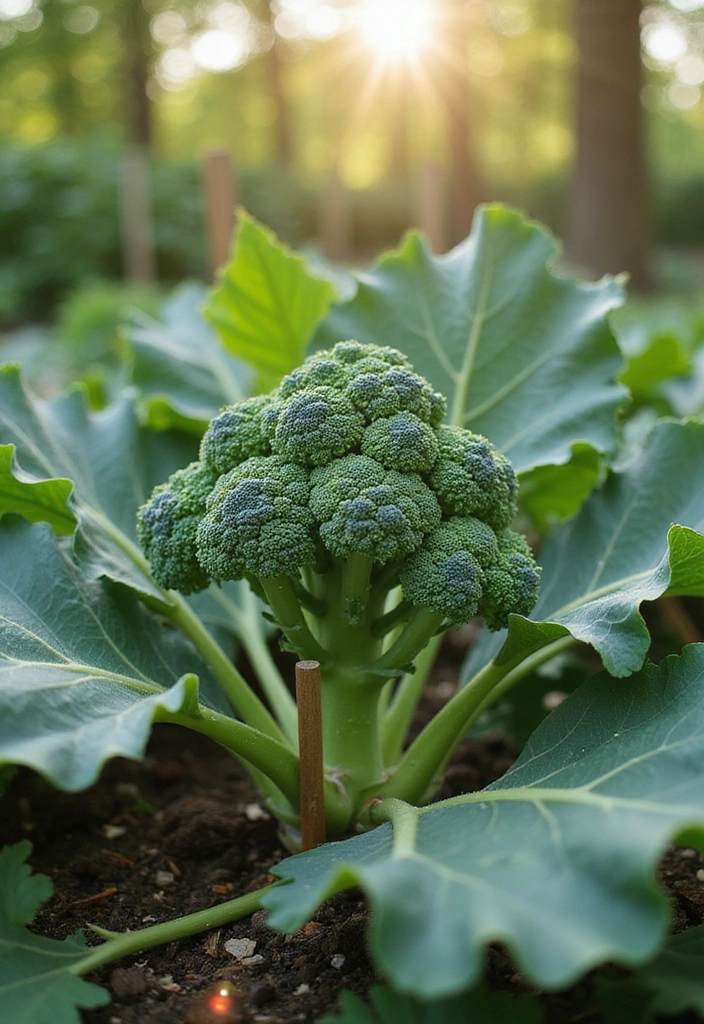
As your broccoli plants mature, you may find that certain varieties require additional support to prevent their heavy heads from tipping over.
Utilizing garden stakes or plant cages can effectively keep your plants upright, especially during those blustery days when winds can be strong.
When installing any support system, be sure to do so gently to avoid causing damage to the roots.
It’s also a good idea to regularly monitor your plants and use plant ties or a garden support kit to adjust the supports as your broccoli continues to grow, ensuring they remain stable and healthy.
Step 8: Harvesting Broccoli
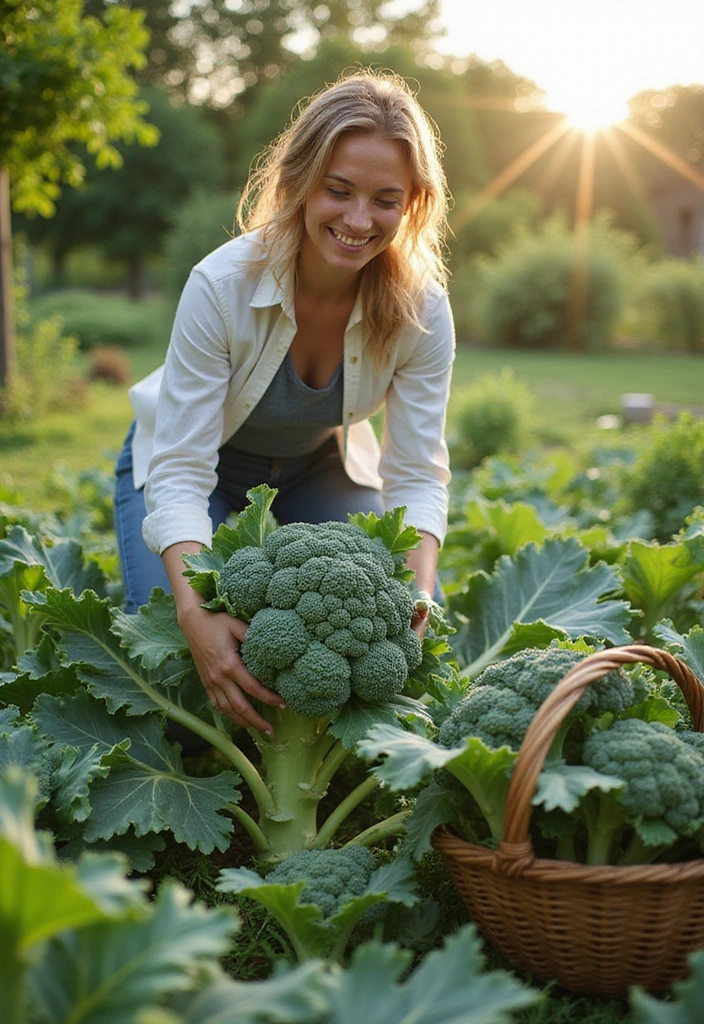
Harvesting broccoli at the perfect moment is crucial for achieving the best flavor and texture.
When the heads are firm, tight, and a rich dark green color, measuring between 4 to 7 inches in diameter, it’s time to gather your bounty. Use a sharp knife, such as this harvesting knife, to cut the head from the plant, ensuring you leave a few inches of stem for future growth.
After harvesting the main head, don’t forget to look for side shoots that can be gathered as well, allowing for multiple harvests throughout the growing season. Keep your freshly harvested broccoli safe in a sturdy produce basket for easy transport, and consider wearing a garden apron to keep your clothes clean while you work. If you plan to prepare your broccoli right away, a reliable vegetable peeler can come in handy for any additional prep.
Lastly, to protect your plants and ensure a healthy crop for the next harvest, consider using an organic pesticide as needed throughout the growing season. Happy harvesting!
Step 9: Storing Your Harvest
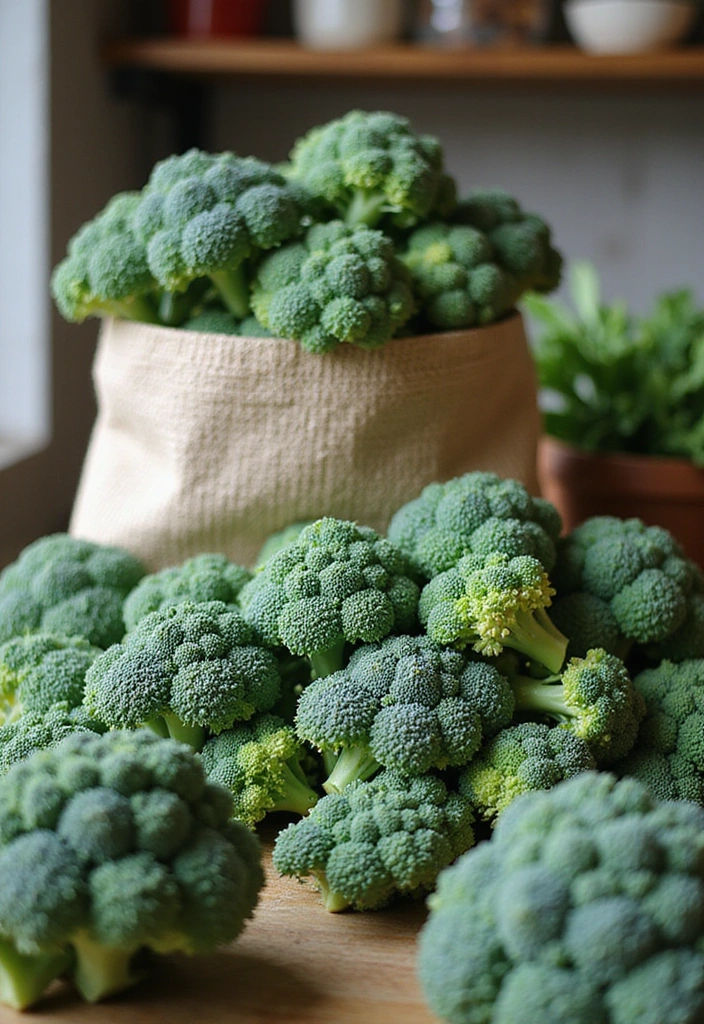
After harvesting your broccoli, it’s crucial to store it correctly to keep it fresh and delicious.
For optimal storage, place the unwashed heads in a perforated plastic bag and store them in the refrigerator, where they can last for up to a week without losing their crispness.
If you want to enjoy your broccoli for an extended period, consider blanching it first and then freezing it in freezer containers. This method helps to preserve its nutrients and flavor, making it a great option for long-term storage.
Additionally, if you’re looking for new ways to incorporate fresh broccoli into your meals, check out a vegetable cookbook for creative recipes. Don’t forget to make your washing and drying process easier with a salad spinner or to use a blanching basket for perfectly prepared vegetables!
Step 10: Continuing Your Gardening Journey
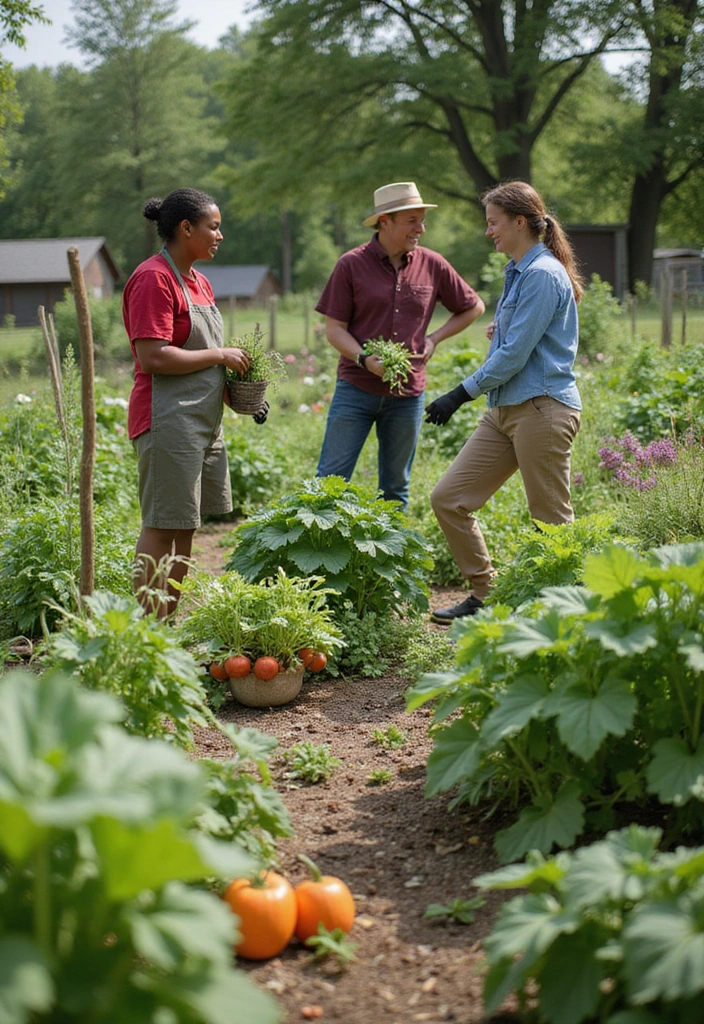
After savoring the satisfaction of growing your own broccoli, why not take the next step and expand your home garden with an array of other vegetables?
Consider venturing into the worlds of kale, cauliflower, or a variety of leafy greens that flourish under similar conditions. To enhance your gardening knowledge, investing in a gardening book can provide you with invaluable tips and techniques.
Additionally, a vegetable garden planner can help you organize your planting schedule and ensure a bountiful harvest throughout the seasons.
Don’t forget to keep learning and adapting your gardening strategies based on your experiences. Joining local gardening groups or exploring online gardening courses can connect you with fellow enthusiasts, allowing you to share tips and discover innovative ideas for vegetable gardening.
Finally, consider becoming a part of a garden community membership to further enrich your gardening journey and enjoy the camaraderie of like-minded gardeners. Happy gardening!
Step 11: Understanding Seasonal Changes

Broccoli is a cool-weather crop that flourishes particularly well in the spring and fall.
To achieve optimal growth, it’s essential to understand your local climate and the seasonal changes that come with it. For those in warmer regions, consider planting your broccoli in late summer to enjoy a bountiful fall harvest. In contrast, if you’re situated in cooler climates, early spring is the ideal time to sow your seeds.
To assist you in planning your planting schedule effectively, using a Gardening Calendar can provide valuable insights into the best planting dates. Additionally, referencing a Climate Zone Map will help you understand the specific conditions of your area.
Monitoring temperatures is crucial, and a Temperature Sensor can aid in tracking fluctuations that may affect your crop. Lastly, having Frost Protection Fabric on hand will safeguard your plants from unexpected frosts, ensuring a successful harvest. For more comprehensive advice on seasonal gardening, check out a Seasonal Gardening Guide to enhance your gardening knowledge and skills.
Step 12: Experimenting with Companion Planting

Companion planting is a fantastic way to enhance the growth of your broccoli while naturally deterring pests. By incorporating plants like basil, mint, and marigold, you can attract beneficial insects that support your garden’s health and repel harmful ones.
To get started, consider investing in flower and herb seeds that can complement your broccoli plants beautifully. Additionally, a comprehensive companion planting guide will provide you with valuable insights into which plants work best together.
Creating a diverse garden not only promotes healthy growth but also enhances biodiversity. Consider using organic pest control solutions to further protect your crops.
Lastly, don’t forget to utilize a garden planner to help you design a layout that integrates flowers alongside your vegetables, creating a beautiful and productive garden. To attract even more pollinators, try planting pollinator attractant seeds for a vibrant and thriving ecosystem in your backyard.
Step 13: Learning from Mistakes

Every gardener inevitably encounters challenges along the way, and understanding how to learn from these mistakes is crucial for your growth as a gardener.
To enhance your gardening experience, consider keeping a gardening journal. This tool will allow you to document what works well and what doesn’t, enabling you to refine your techniques over time.
Regularly assess your watering schedule, soil conditions, and pest management strategies. A soil testing kit can be invaluable in understanding your soil’s health and nutrient levels, which can significantly impact your broccoli’s growth.
Additionally, sharing your experiences with fellow gardeners through online gardening forums can provide you with fresh insights and support. You might even consider joining gardening workshops to learn new techniques and connect with others who share your passion. Embrace the learning process, and you’ll enjoy a bountiful harvest in no time!
Step 14: Embracing Organic Gardening
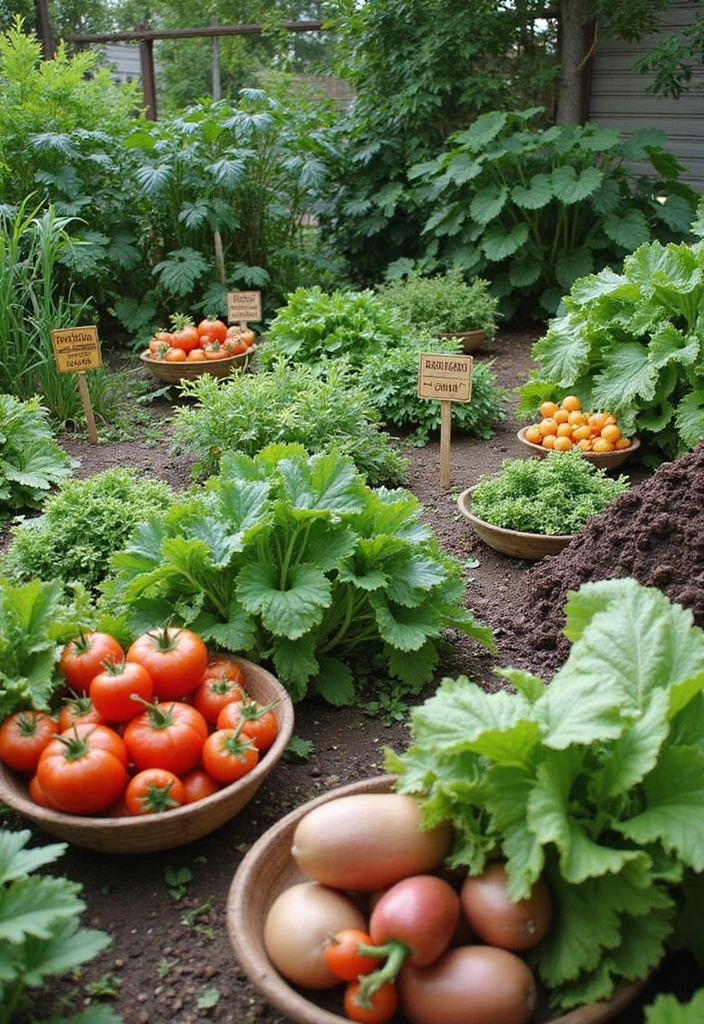
Embracing organic gardening practices not only leads to healthier plants but also fosters a more sustainable environment. By utilizing organic fertilizers, you can enrich your soil and provide essential nutrients that support robust growth.
Incorporating a compost bin into your gardening routine allows you to recycle kitchen scraps and yard waste, creating nutrient-rich compost that enhances soil health while promoting biodiversity.
When it comes to managing pests, consider using natural pest control solutions that minimize chemical inputs and protect beneficial insects.
Additionally, exploring organic gardening books can provide you with valuable insights and techniques to cultivate your garden sustainably.
Finally, integrating soil amendments can further improve soil structure and fertility, ensuring that your plants thrive in a healthy ecosystem. Embracing these organic methods not only benefits your garden but also contributes positively to the environment around you.
Step 15: Celebrating Your Harvest

Once you’ve successfully grown and harvested your broccoli, it’s time to celebrate the fruits of your labor!
Consider hosting a delightful garden party or a family dinner that highlights your fresh produce. You can enhance your gathering with garden party supplies that will elevate the atmosphere and create a festive ambiance.
As you share delicious recipes from your own kitchen, why not document your culinary creations with recipe cards? This not only preserves your cooking adventures but also provides a lovely keepsake for your guests.
Take a moment to reflect on your journey from seed to harvest; consider capturing those memories with photos or even starting a blog to inspire others to embark on their own vegetable gardening adventures. You could also gift some of your gardening friends with gardening-themed gifts to encourage them.
To complete your outdoor festivities, an outdoor dining set will ensure you have the perfect setup to enjoy your meal in the fresh air. Celebrate your hard work and make memories that will last a lifetime!
Conclusion

Growing broccoli at home can be a fulfilling and delightful experience, connecting you to nature and providing fresh produce for your meals.
By following these steps and embracing the journey, you’ll not only enjoy a bountiful harvest but also cultivate a passion for vegetable gardening that can last a lifetime.
So, roll up your sleeves, get your hands in the soil, and let the adventure begin!
Note: We aim to provide accurate product links, but some may occasionally expire or become unavailable. If this happens, please search directly on Amazon for the product or a suitable alternative.
This post contains Amazon affiliate links, meaning I may earn a small commission if you purchase through my links, at no extra cost to you.

